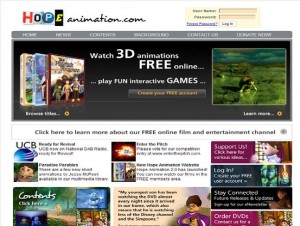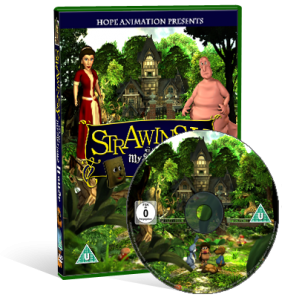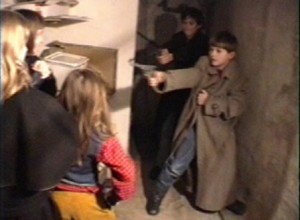
No qualifications, experience or budget
– let’s do it!
Many years ago – in 2007 to be precise – I decided that it would be really cool to create a 3d animated movie. At that time I was finishing my Business and Marketing degree at Canterbury Christ Church University in England.
As you might probably guess – having a degree in Business is not necessarily the best foundation that really prepares you for making cartoons. So whilst I really enjoyed my studies and learned a lot of useful stuff, I had zero training or qualifications in media or animation, had no budget, software or equipment and still had fairly limited computer knowledge overall. I had never done any animation before, had pretty much no experience with Photoshop and just three years prior – at the beginning of my degree – couldn’t even use simple desktop publishing software such as Microsoft PowerPoint.
What I didn’t lack however was lots of enthusiasm, passion, excitement, stubborn determination, a sometimes irrational “can do” spirit and complete and utter naivety about the complexity and effort that goes into the development and production of an animated movie.
The power of animation

I was inspired by a series of animated movies by Scott Cawthon, an animator from the US, which I accidentally came across during my time at university. Whilst I’ve always been interested in movies and film-making, I wasn’t really into animations. I always believed it was impossible to create anything substantial without having millions of pounds to invest and an army of animators to command. I also assumed that this was a genre that only appealed to children and therefore was entirely unsuitable for communicating a more adult message.
When watching his Pilgrim’s Progress animation, however, I was totally shocked how the animation connected with me emotionally and even moved me to tears. I was amazed how Scott could create hour long animated movies that far exceeded the quality of early VeggieTales animations all by himself – in his spare time – whilst holding a full time job.
As I was a Christian, passionate about my faith but often unable to communicate it appropriately, this seemed to me a very powerful tool to share the hope and truths that I had discovered and experienced over the years, in an engaging and meaningful way.
First steps
So I ventured out, got hold of an education-only license for a state-of-the-art animation software package that I was told was also used for feature films such as Harry Potter and slowly started to work my way through hundreds of tutorials, exercises and manuals.
My progress was very slow. I didn’t have a fast computer, was finishing my degree, had to write lots of job applications and eventually started to work 50 hour weeks shared across two part-time jobs as I was trying to make ends meet in order to get established in the world of business.
Hope Animation
In addition I really wanted to help promote Scott Cawthon’s animations as they had given me such a huge amount of hope and inspiration. I contacted lots of Christian publishers and distributors to see if they would like to include Scott’s animations in their catalogues. To my disappointment however I received rejection letter after rejection letter. These often only came in after I had sent out lots of follow-up emails chasing my contacts for any kind of response.
Consequently I decided to distribute the animations myself and started up a little website called Hope Animation. As if learning how to make an animated movie was not enough I started to teach myself web design and programming skills. This also proved to be very useful for my day job and I was able to give Scott’s DVDs away for free.
Anyone interested in his animations could send me a message via the site stating which DVDs they would like and where to post them to. People could give donations if they wanted to, but were not obliged to do so. This worked really well for the first 2-3 years and 100s of parcels were sent to England, the US, Germany and even as far as Australia, Malaysia and Indonesia. We received some fantastic and very encouraging feedback from people all across the world – some of which you can still read on our website.
Maintaining a balance to stay on mission
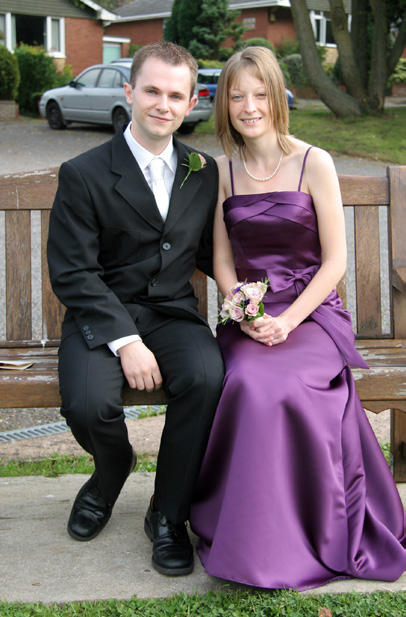
This first experience and feedback gave me a lot of boost and encouragement to go ahead and keep learning how to make animations. It was difficult to find spare time as my jobs were demanding and life was busy. Very soon I realised that in order to remain spiritually healthy I had to ensure that I kept a careful balance between my work, marriage, animation, friends and family, church, our social life and time for learning and reflection. I felt it was really important to maintain a very high level of positive intake through sermons, books and prayer because I knew that I could only give as much as I had received. Otherwise I would quickly burn out with a hectic schedule, increasing demands, growing frustrations and a lack of spiritual nourishment and refreshment.
I set myself a clear order of priorities that started with my relationship with God, then my marriage, next my work and finally – at the bottom of the pile – my animation project. As you probably would expect the progress of my animation was therefore still very slow and not much was happening yet…
For the first two years I wrote myself a basic mission statement:
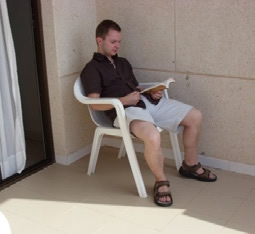
Foundation: The Bible and prayer are of utmost importance for everything I do. All my decisions and attitude should be based on this foundation.
1. Skills: To become as professional in my work as possible
2. Networks: To develop friend- and partnerships with likeminded artists and supporters
3. Finance: Trust God to help me finance the project through my work and donations from supports and website visitors.
Aim: To honour and praise God, teach and encourage people

Whenever I found time to work on my animation project, I made the most of any opportunity for further training and study as I believed it would be necessary to become as professional in my work as possible to make a positive impact. I’ve completed a video training course with Vivid Broadcast that taught me lots about camera work, lighting and composition. I continued to read software manuals and tutorials, watched online training videos and kept practising the various skills I had learnt.
The birth of Strawinsky
Some additional work and overtime enabled me to purchase my first high-speed animation computer. With a limited budget I was able to get a custom-built eight-core render machine that proofed to be a good starting point for creating fairly detailed, high-resolution images. One of the things I didn’t consider though was how much cooling power it all required. So whilst it was lightning-fast for its time, it was very noisy and sounded a lot like a helicopter!
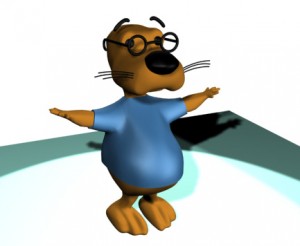
In February 2009 I finally started work on Strawinsky, the main character of my first animated movie “Strawinsky and the mysterious house”. The story is based on a six episode fantasy series that was released as a Christian audio drama in the 1980s in Germany. Whilst I used to listen to it as a child, it was already out of print for several years when I contacted the German publisher to get official permission for creating an animation based on one of the episodes.

By that point it was already very clear to me that creating a cartoon is quite difficult all by itself. So I was very glad that I didn’t also have to come up with my own story but could rely on a tale that I really enjoyed as a child myself!
A world of magic and meaning
Overall, the series is about Strawinsky, a little mole, who lives in an enchanted, magical, fantasy world. The kingdom he lives in is ruled by a kind and benevolent monarch, the Great Elohim, his son (the Prince), and the Scarlet Queen. The land however is also plagued by an evil tyrant – the Ratking – and his vermin horde which cause Strawinsky and his friends to live through many hardships and adventures.
One of the elements that first attracted me to this series was its slight similarities to the “Chronicles of Narnia”. I really like the way the narrative explores fairly grown-up, spiritual and Christian themes in the context of a larger fantasy setting. A lot of the subplots are based on the parables by Jesus in the Bible and contain deeper meanings that might not always be obvious at first glance. Some elements are also quite similar to Walt Disney animated movies (which I love) – such as “The Lion King” and “Beauty and the Beast” where songs and music add a further dimension to the story telling. I was hoping the songs would lighten up the story and make it fun to watch the film over and over again.
Starting in the middle of the story
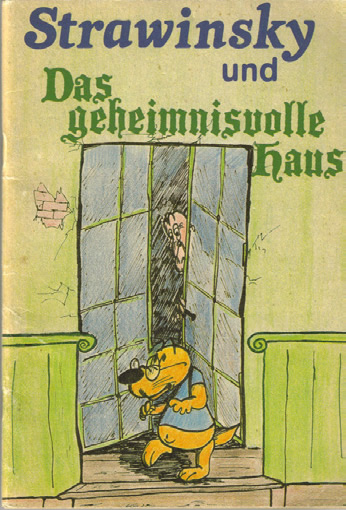
The episode I chose turned out to be part number three of the overall series and therefore presupposes some basic background knowledge of previous episodes. For example, the Ratking, Scarlet Queen and Great Elohim aren’t properly introduced. Unfortunately, there wasn’t much I could do about this. As I had never done any animated movies before, the first two parts were far too ambitious for me in terms of their locations, setting, story and effects. I therefore decided it would be a lot more realistic to start with a movie that takes place in a single, small location, i.e. a mysterious house! And thinking back to movie history, I comforted myself that other epics such as Star Wars had started right in the middle of the story, too…
I was also aware that my modelling and animation skills were most likely to improve as I was working on the animation. So I started right in the middle of the story with Strawinsky meeting the depressed cello because I wanted to avoid creating a movie that gradually improves in quality as you watch it from beginning to end. My aim was to create the opening and closing scenes of the animation last in order to grab people’s attention right from the start of the movie with high quality images and animation.
Seeing the world with new eyes
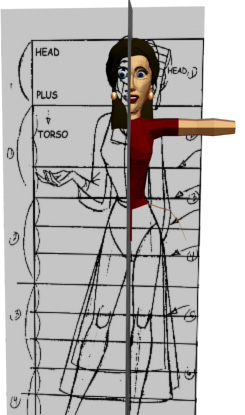
When you’ve never done anything like this before, animation can be quite a steep learning curve. Nonetheless, it’s also very rewarding. It’s fascinating to see how locations, characters and eventually full scenes develop as anything you can imagine slowly becomes reality. Whilst I often ended up very frustrated as my images and characters were initially looking very amateurish and crude, my eyes were slowly opened to things I had never noticed before.
Skirting boards in rooms for example – I’ve never been consciously aware of them until I was creating my first interior locations and I realised that something was missing.
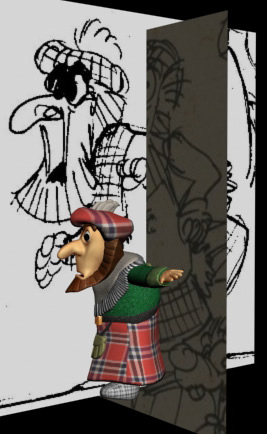
I started to learn about architecture, cloth making, soft and hard shadows, how four-legged animals walk, the importance of textures, colours and lighting, the bone structure and movement of eagle wings and much more. I loved the fact that I could rely on the computer to calculate accurate lighting and shadows frame after frame.
Some technical info – feel free to skip… 😉
Traditional animation requires hundreds of animators to draw frame after frame – often having to start from scratch for every single scene. If you work with 25 frames per second that means you need to produce 1,500 images for every minute of film.

Computer animation in comparison allows you to “simply” build your locations and characters as a re-usable asset. As soon as your location is ready and you have created the key frames for your puppets you can place a camera and lights into the scene and tell the computer to calculate the images for you from whatever angle you want.
That luxury however comes at its price. Whilst the computer can provide you with photo-realistic renders of your images, this can be very slow. Depending on how many lights you place into a scene it can take very long to calculate a finished picture. For example, if you place a dozen lights in your scene, your computer will have to keep track of millions of rays of light that are being fired into your scene and bounce off the walls and objects to create realistic shading and colours. Other elements such as hair, particle systems, special effects or complex and highly detailed models will also affect your render
times really badly.
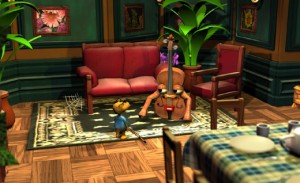
When I started to create my first images with Strawinsky and the Cello, a single frame took my computer approx. 4-5 minutes to render. Towards the end of the production, a single frame of some of the outside scenes took up to 15-20 minutes to compute. If you time this by the amount of images required for half an hour of footage – i.e. approximately 42,000 images – you need to have your computer running for a very long time!
My daily routine…
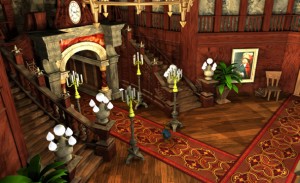
What really helped me with this was the privilege of being able work from home for most of my time. As a lot of my work for the last few years included programming, design, video editing and other e-learning development, it was possible for me to switch the computer on first thing in the morning and keep it running in the background whilst I was working on another computer.
Once it was time for bed in the evening I switched it all off again just to repeat the same procedure on the next day.
Lost in translation
In early 2011 I was nearing the end of my production. All of the images were complete and the “only” thing left was to translate the German voice-overs into English. I always thought that would be the easiest task as the hardest work must have been done with the animation.
I was very surprised, however, how difficult it turned out to record good quality audio and to find talented people that can act and sing. Gulbert Bibberkrall’s voice for example was very hard to cast… Try to find someone in South East England who can sing and act with a fairly high pitched Scottish accent! Especially if you’re on a very tight budget and rely on the goodwill and favour of friends and acquaintances…
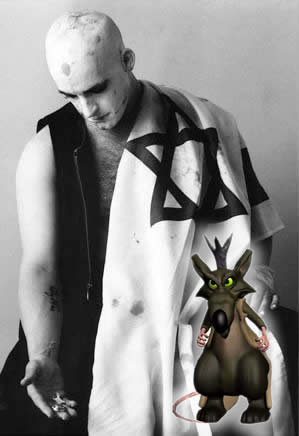
As I was struggling to find suitable voices and slowly learned more about audio recording I had the idea to contact Eric Clayton, the singer of “Saviour Machine”, a “Christian” gothic rock band from California that I quite liked and sometimes listened to. He agreed to record the voice of the Ratking for an acceptable fee that I hoped to recoup from sales of the finished animation to his sizable fan base.
Slowdown to near standstill
The following year turned out to be very paralysing to the final completion and release of Strawinsky. Everything was complete but I was still struggling with the recording of the English voice-overs. Furthermore, work became increasingly busy and demanding due to a large scale e-learning contract we’ve started to work on. Whilst my job is a definite blessing, it was necessary to work quite a lot of overtime.
In addition, we wanted to buy our first home as we had saved up a deposit over the previous few years. Consequently a lot of our spare time was used to learn about mortgages and to scout out the property market. We finally purchased a house in a neighbouring town and moved from Canterbury to Ashford in August 2011.
Strawinsky 3d
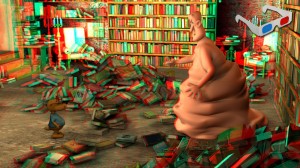
During my down-time I started to render out a 3d version of the animation that can be viewed with 3d glasses. There are two types of 3d – anaglyph (with two coloured glasses) and stereoscopic (the kind of 3d that you see in cinemas these days). You don’t need a special kind of TV or player for the anaglyph version. That’s why I’ve included this version on the final DVD. I’d definitely recommend though watching the non 3d version first as the colours are much better and the depth of field in the original gives it more of a cinematic feel.
Finishing touches
After many months of waiting I also received some great recordings from Eric Clayton that provided me with a good benchmark for any of the other voice recordings. Having moved to a new place, we settled at a new church that was quite a lot larger than our previous one. There I eventually found some very talented people – some of which even had professional acting backgrounds and qualifications – that could assist with the recording of the English voice-overs. Finally, another month was spent on adding a layer of sound-effects to the finished movie.
Some further frustrating months were spent waiting to hear about a final permission regarding the rights surrounding Strawinsky.

During that time I designed the Strawinsky website, created a graphic novel based on the animation and started to plan the promotion and distribution of the finished movie. Finally in October 2012 the film was ready for the official rating agencies in the UK and Germany and could be sent to the printer…
Was it worth all the effort?
My brother recently asked me: Based on what I know now, would I do it again? Was it worth the effort? Well, I guess only time will tell whether the animation will have any impact, whether people will like it and whether anything else will come from it.
Nonetheless, having toiled through difficulties, frustrations and disappointments and to have finally completed the animation has certainly changed me. I’ve felt that I’ve grown in skills, character, patience and faith – God certainly works in you before he works through you!
In addition I now also have a very powerful toolset ready at my disposal for new (and hopefully easier!) projects. So yes, I’d say it was worth it just for that. And who know what the future will hold… I’m certainly not lacking in ideas for new endeavours!
Curious to see the full movie? Get your copy here!
You might also be interested in:
> The Message of Strawinsky
> Miracles – my personal story of healing
> Running the race on spiritual fast-food
> Who is the Scarlet Queen




